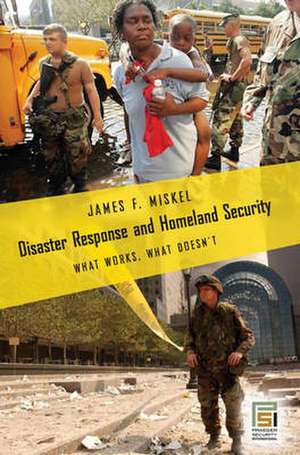Disaster Response and Homeland Security: What Works, What Doesn't: Praeger Security International
Autor James Miskelen Limba Engleză Hardback – 29 aug 2006 – vârsta până la 17 ani
| Toate formatele și edițiile | Preț | Express |
|---|---|---|
| Paperback (1) | 126.03 lei 3-5 săpt. | |
| Stanford University Press – 17 feb 2008 | 126.03 lei 3-5 săpt. | |
| Hardback (1) | 333.72 lei 6-8 săpt. | |
| Bloomsbury Publishing – 29 aug 2006 | 333.72 lei 6-8 săpt. |
Din seria Praeger Security International
- 18%
 Preț: 334.19 lei
Preț: 334.19 lei - 8%
 Preț: 335.53 lei
Preț: 335.53 lei - 34%
 Preț: 376.10 lei
Preț: 376.10 lei - 46%
 Preț: 443.64 lei
Preț: 443.64 lei - 29%
 Preț: 240.11 lei
Preț: 240.11 lei - 8%
 Preț: 304.56 lei
Preț: 304.56 lei - 34%
 Preț: 373.82 lei
Preț: 373.82 lei - 19%
 Preț: 412.79 lei
Preț: 412.79 lei - 19%
 Preț: 338.42 lei
Preț: 338.42 lei - 18%
 Preț: 335.62 lei
Preț: 335.62 lei - 27%
 Preț: 377.35 lei
Preț: 377.35 lei - 27%
 Preț: 376.75 lei
Preț: 376.75 lei - 18%
 Preț: 336.46 lei
Preț: 336.46 lei - 18%
 Preț: 321.73 lei
Preț: 321.73 lei - 27%
 Preț: 384.51 lei
Preț: 384.51 lei - 18%
 Preț: 320.50 lei
Preț: 320.50 lei - 18%
 Preț: 320.50 lei
Preț: 320.50 lei - 18%
 Preț: 321.35 lei
Preț: 321.35 lei - 24%
 Preț: 420.54 lei
Preț: 420.54 lei - 14%
 Preț: 335.99 lei
Preț: 335.99 lei - 18%
 Preț: 355.82 lei
Preț: 355.82 lei - 18%
 Preț: 319.83 lei
Preț: 319.83 lei - 18%
 Preț: 334.28 lei
Preț: 334.28 lei - 32%
 Preț: 354.48 lei
Preț: 354.48 lei - 14%
 Preț: 335.14 lei
Preț: 335.14 lei - 38%
 Preț: 405.98 lei
Preț: 405.98 lei - 40%
 Preț: 571.34 lei
Preț: 571.34 lei - 18%
 Preț: 321.85 lei
Preț: 321.85 lei - 18%
 Preț: 323.25 lei
Preț: 323.25 lei - 18%
 Preț: 253.28 lei
Preț: 253.28 lei - 40%
 Preț: 571.50 lei
Preț: 571.50 lei - 18%
 Preț: 301.73 lei
Preț: 301.73 lei - 19%
 Preț: 352.96 lei
Preț: 352.96 lei - 26%
 Preț: 387.80 lei
Preț: 387.80 lei - 18%
 Preț: 302.77 lei
Preț: 302.77 lei - 14%
 Preț: 333.91 lei
Preț: 333.91 lei - 17%
 Preț: 325.80 lei
Preț: 325.80 lei - 24%
 Preț: 338.58 lei
Preț: 338.58 lei - 34%
 Preț: 414.73 lei
Preț: 414.73 lei - 18%
 Preț: 354.30 lei
Preț: 354.30 lei - 29%
 Preț: 254.29 lei
Preț: 254.29 lei - 18%
 Preț: 354.11 lei
Preț: 354.11 lei - 18%
 Preț: 334.38 lei
Preț: 334.38 lei - 14%
 Preț: 302.68 lei
Preț: 302.68 lei - 18%
 Preț: 322.97 lei
Preț: 322.97 lei - 27%
 Preț: 376.50 lei
Preț: 376.50 lei - 27%
 Preț: 322.81 lei
Preț: 322.81 lei - 27%
 Preț: 382.91 lei
Preț: 382.91 lei - 18%
 Preț: 320.87 lei
Preț: 320.87 lei
Preț: 333.72 lei
Preț vechi: 389.94 lei
-14% Nou
Puncte Express: 501
Preț estimativ în valută:
63.86€ • 69.35$ • 53.65£
63.86€ • 69.35$ • 53.65£
Carte tipărită la comandă
Livrare economică 22 aprilie-06 mai
Preluare comenzi: 021 569.72.76
Specificații
ISBN-13: 9780275992118
ISBN-10: 027599211X
Pagini: 176
Dimensiuni: 156 x 235 x 20 mm
Greutate: 0.43 kg
Editura: Bloomsbury Publishing
Colecția Praeger
Seria Praeger Security International
Locul publicării:New York, United States
ISBN-10: 027599211X
Pagini: 176
Dimensiuni: 156 x 235 x 20 mm
Greutate: 0.43 kg
Editura: Bloomsbury Publishing
Colecția Praeger
Seria Praeger Security International
Locul publicării:New York, United States
Notă biografică
James F. Miskel is a consultant for the defense consulting firm Alidade Inc. Until 2005 he served for 12 years as Professor of National Security Affairs at the Naval War College, where he still teaches online courses in the graduate degree program. During the Reagan and (first) Bush Administration he served on the National Security Council.
Cuprins
Preface1. Disaster Response in the United States: How the System Is Supposed to Work2. When the System Fails3. Disaster Relief and the Military: Civil Defense and Homeland Security4. Hurricane Agnes, Three Mile Island, and the Establishment of FEMA5. Hurricanes Hugo and Andrew6. Hurricane Katrina7. Two Other Models8. Conclusion and RecommendationsNotesSelected ResourcesIndex
Recenzii
The US government's failed response to the Hurricane Katrina disaster of 2005 fits into a pattern of failure to meet the needs of victims of catastrophic disasters, according to Miskel. This pattern points to systemic problems, rather than simply incompetence on the part of individual leaders systemic problems he seeks to uncover through comparative examination of how the government's disaster relief system operated during Hurricane Agnes in 1972, the Three Mile Island near-disaster in 1979, Hurricane Hugo in 1989, Hurricane Andrew in 1992, and Hurricane Katrina. After identifying the enduring structural issues revealed in these examples, he compares the US system to its Australian and Canadian counterparts and proposes some fundamental changes.
[M]iskel, a former Deputy Assistant Associate Director of FEMA, examines the effects that operational failures after Hurricaines Agnes, Hugo, Andrews, and Katrina have had on the organizational design and operating principles of the disaster response system program. He also discusses the impact of 9/11 and the evolving role of the military, and he identifies reforms that should be implemented to improve the nation's ability to respond in the future.
[M]iskel, a former Deputy Assistant Associate Director of FEMA, examines the effects that operational failures after Hurricaines Agnes, Hugo, Andrews, and Katrina have had on the organizational design and operating principles of the disaster response system program. He also discusses the impact of 9/11 and the evolving role of the military, and he identifies reforms that should be implemented to improve the nation's ability to respond in the future.
















